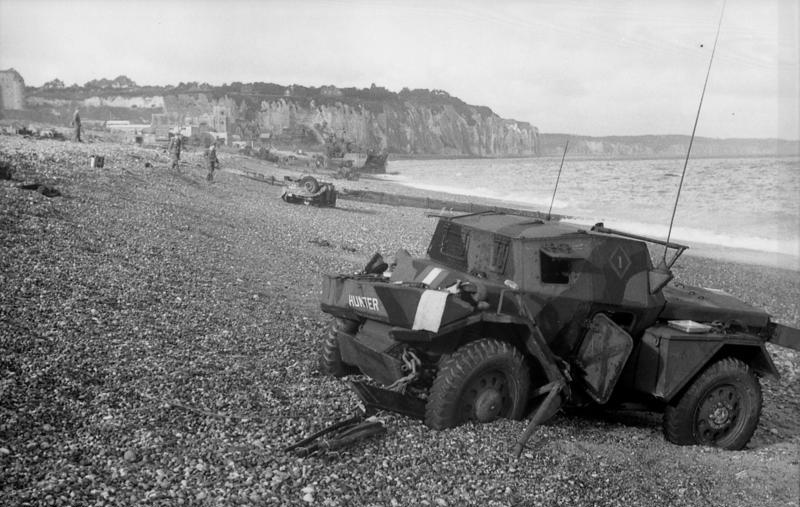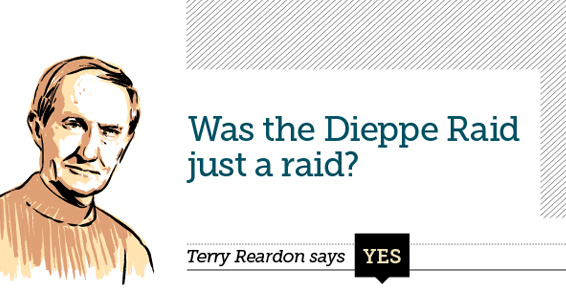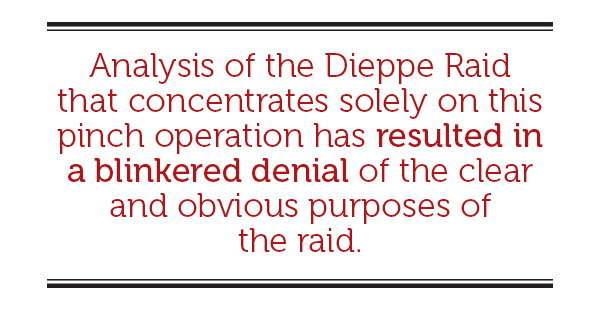
Dieppe’s chert beach and cliff immediately following the raid on 19 August 1942. A Dingo Scout Car has been abandoned. [Bundesarchiv, Bild 101I-362-2211-04 / Jörgensen / CC-BY-SA 3.0]

TERRY REARDON is vice-chair of the International Churchill Society Canada and the author of Winston Churchill and Mackenzie King, So Similar, So Different. [Illustration by Greg Stevenson/i2iart.com]
Soviet Minister of Foreign Affairs Vyacheslav Molotov met with President Franklin D. Roosevelt, who, concerned that Russia might make peace with Germany, promised a second
front in 1942.
That promise was irresponsible because there were insufficient troops and landing craft. Still, something had to be done, and Roosevelt wrote to Prime Minister Winston Churchill to demand action. Churchill’s reaction was to direct Chief of Combined Operations Lord Louis Mountbatten to plan a major attack on the northern French coast. This resulted in the largest amphibious raid since the Gallipoli Campaign in 1915. The target was the English Channel port of Dieppe, and the objectives were to encourage Hitler to divert troops from Russia and for the Allies to obtain intelligence for a future invasion of France.
Churchill arrived in Moscow on Aug. 12, 1942, to deliver the unpalatable news to Stalin that there would be no second front that year. Their heated exchange cooled down when Churchill stated that to make the Germans more anxious regarding an attack from across the channel, there would be a major reconnaissance raid.
“They will stay a night and day, kill as many Germans as possible and take prisoners,” Churchill promised. “Then they will withdraw…. The object is to get information and to create the impression of an invasion.”

In the early days of 1942, the Allies were severely hampered in gathering intelligence; before then, they had been able to read German military messages because they had broken the three-rotor Enigma machine code, but a four-rotor machine was introduced and the boffins were stymied (see page 94).
Part of the Dieppe Raid included a platoon of Special Operations Executive commandos assigned to enter the local headquarters of the German navy and conduct a pinch to seize a navy cipher machine (ideally) and (at least) codes and other secret documents. This involved detailed planning and the involvement of the British Naval Intelligence Division.
Analysis of the Dieppe Raid that concentrates solely on this pinch operation has resulted in a blinkered denial of the clear and obvious purposes of the raid. The revisionist theory requires one to accept that 245 ships and landing craft carrying 6,100 troops, landing on six beaches with 58 tanks and the participation of 74 air squadrons comprising 1,000 aircraft were involved just to be a cover for the pinch. Wow, that’s some stretch!
While this fresh theory has received much publicity, it does not stand up to even a superficial examination, and has been decried in several reviews by respected Canadian historians. It would be comforting to justify the disastrous raid and the tragic loss of life by having a more crucial purpose, but it just isn’t so.

DAVID O’KEEFE teaches modern and military history at Marianopolis College in Westmount, Que. He wrote One Day in August: The Untold Story Behind Canada’s Tragedy at Dieppe, a bestselling re-examination of the disastrous raid. [Illustration by Greg Stevenson/i2iart.com]
To mount an amphibious raid when resources—destroyers and landing craft—were scarce required objectives that were vital and in the direct interest of the Chiefs of Staff and Royal Navy. At this point, control of the sea lanes that underpinned the Allied war effort, the establishment of a second front, and supplying the Soviets were all considered in direct interest.
With Allied shipping beleaguered by submarines in 1941, codebreaking had come to the rescue after pinch raids helped break the three-rotor naval Enigma machine encryption. This swung the balance of the Battle of the Atlantic toward the Allies. When an improved four-rotor machine came into operation early in 1942—first on U-boats in the Atlantic and then on surface craft in the English Channel—that balance shifted again and the British felt another pinch was the only hope.
But with the Allies on the defensive, the only force capable of pinching was Mountbatten’s COHQ which, in conjunction with Naval Intelligence, had developed a policy for systematically pinching ashore under the guise of large raiding operations where “the scope of the objectives should always be sufficiently wide to presuppose normal operational objects.”
Unlike larger operations planned at that time to divert German resources from the Eastern Front, Dieppe was its own beast; fifth in a series of pinch raids that followed the successful raids on the islands of Lofoten and Vågsøy in Norway and the unsuccessful ones at Saint-Nazaire and Bayonne in western France.

On March 13, 1942, confirmation came that vessels frequenting Dieppe carried the four-rotor and planners suspected the harbour offered what codebreakers called “the whole bag of tricks”—cipher keys, tables, lower-level codes for cribs and the machine itself, located on vessels, in a portside naval headquarters or in the local communications supply depot. These targets fell into the A1 category which, according to policy, justified the mounting of special operations and incurring of heavy casualties if necessary.
Planning started following this confirmation and was led by the same syndicate at COHQ that orchestrated the previous pinches. In the outline plan, laid down in conjunction with Naval Intelligence, the pinch was front and centre with the rest of the operation to be built up around it, following approval by the Chiefs of Staff.
The plan had all the hallmarks of the pinch policy: over-reliance on surprise, speed and shock; a direct route to the target; suppressive rather than destructive firepower; multiple contingencies built in to capture the material; a pipeline to get it out; a destruction plan to cover the pinch; and preordained press messaging to mask the intent. Sadly, with more than half the deaths in the raid coming in direct pursuit of these objectives, Dieppe was never “just a raid.”
Advertisement





















